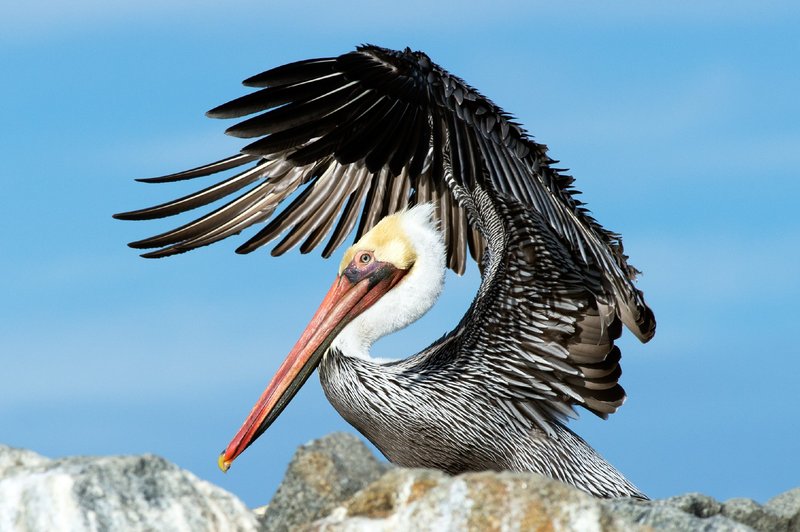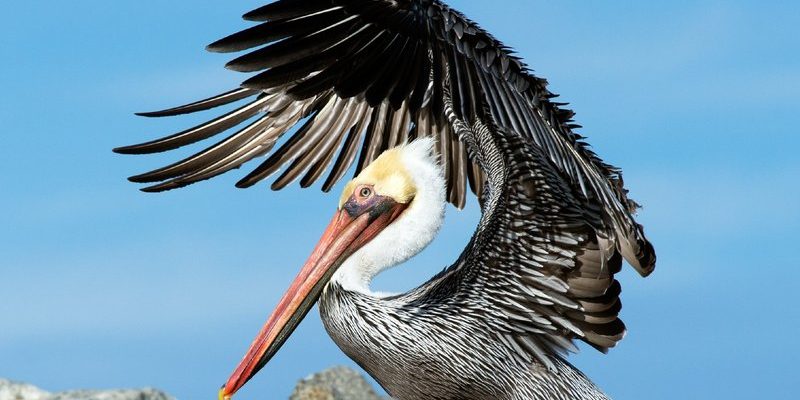
The Brown Pelican is a fascinating bird that often captures the attention of anyone lucky enough to spot it soaring gracefully over coastal waters. With its striking appearance and unique hunting style, this bird is not just a common sight; it’s a coastal icon. Imagine yourself walking along the beach, the salty breeze brushing your face, and there, gliding effortlessly above the waves, you see a Brown Pelican. Its large bill and distinctive plumage make it a photographer’s dream and a nature lover’s delight.
These birds, with their impressive wingspans and unique fishing techniques, have captivated humans for generations. From their clumsy landings to their acrobatic dives, Brown Pelicans are a reminder of nature’s beauty and ingenuity. Let’s dive into the world of this remarkable bird, exploring its habitat, behavior, and the fascinating traits that make the Brown Pelican so special.
Physical Characteristics
The Brown Pelican is easily recognizable thanks to its distinctive features. Adult pelicans can reach lengths of about 40 to 54 inches and have a wingspan that stretches an impressive 6 to 7.5 feet. What’s more interesting is their weight, which ranges from 6 to 12 pounds. You might not think of them as heavy, but when you consider their size, it’s quite substantial!
One of the most striking features is their long, pointed bill. It can be as long as 18 inches, allowing them to scoop up fish with remarkable efficiency. The bill’s length is complemented by a unique throat pouch, which can hold up to three gallons of water—imagine carrying that much in your mouth! This adaptation is essential for their feeding strategy, making them one of the most efficient fishermen in the bird world.
When it comes to coloration, the Brown Pelican is mostly brown with a lighter head. Their feathers can vary from a deep chocolate to a more grayish hue, making each individual unique. Juvenile pelicans may look quite different with more mottled feathers until they reach maturity. This evolving look is just part of their charm.
Habitat and Distribution
Brown Pelicans are typically found along the coastlines of the Americas, from the northern parts of the United States down to Brazil. They thrive in a variety of marine environments, such as bays, estuaries, and coastal waters. You might spot them resting on piers or dive-bombing into the ocean for fish. Their versatility in habitat choice allows them to adapt to different coastal ecosystems.
These birds prefer warm, tropical, and subtropical climates, with a strong preference for areas where fish are plentiful. They are often seen in large groups, especially during the breeding season, making beaches and rocky shorelines bustling with their activity. During migration periods, they can also be spotted further inland at times, as they search for new feeding grounds.
Their nesting habits are quite interesting as well. Brown Pelicans typically nest on cliffs or in trees near water. They create nests from sticks and other materials, and both parents help incubate their eggs. This cooperative breeding is a key part of their family dynamics.
Feeding Habits
The Brown Pelican is primarily a fish-eater, which is reflected in its impressive hunting techniques. They are known for their dramatic aerial dives, where they can plunge from heights of up to 60 feet to catch fish just beneath the water’s surface. It’s like watching a high-speed ballet as they swoop down, plunging their bill into the water with stunning accuracy.
Once they catch their prey, they use their large throat pouch to hold the fish while they filter out the water before swallowing. This method is not just efficient but also entertaining to watch. You might even find yourself wondering how they manage to do it without getting hurt! Additionally, they primarily feed on fish like sardines and mullet, but they will also eat crustaceans when the opportunity arises.
Brown Pelicans have excellent eyesight, which helps them spot fish from the air. They can also work together during feeding to drive fish into tight schools, which makes for easier hunting. Their social nature while feeding often results in a lively atmosphere as multiple pelicans dive at once.
Breeding and Nesting
Brown Pelicans are known for their complicated courtship displays. Males typically perform elaborate dances and displays to attract a mate. Once paired, they will establish a nesting territory and build a nest together. Their nests are usually placed on cliffs or in trees close to the water, providing safety and easy access to food.
The female usually lays two to three eggs, and both parents share the responsibility of incubating them. The incubation period lasts around 30 days. Once hatched, the chicks are fed regurgitated fish and remain dependent on their parents for about 10 weeks. During this time, you might spot the adults bringing back food while communicating with their young through soft calls.
Interestingly, Brown Pelicans often return to the same nesting sites year after year, which creates a strong sense of community among the birds. This loyalty to their nesting grounds helps maintain their population in specific areas, contributing to their social structure.
Conservation Status
Despite their resilience, Brown Pelicans have faced significant threats over the years. DDT, a pesticide that was widely used in the mid-20th century, caused severe population declines due to its effects on egg-laying. The eggs would become soft and fragile, leading to lower hatch rates. This is a stark reminder of how human activities can impact wildlife.
Thanks to concerted conservation efforts, the Brown Pelican population has rebounded significantly since the banning of DDT in the 1970s. They have been removed from the Endangered Species List, but they still face challenges like habitat loss, pollution, and climate change. Protecting their coastal habitats is crucial for their continued survival.
Many organizations are working tirelessly to monitor Brown Pelican populations and educate the public about their importance. Participating in local conservation efforts can not only help these birds but also enrich your appreciation for wildlife. Every little action counts!
Table of Interesting Facts
| Common Name: | Brown Pelican |
| Scientific Name: | Pelecanus occidentalis |
| Size: | 40-54 inches (length) |
| Wingspan: | 6-7.5 feet |
| Weight: | 6-12 pounds |
| Diet: | Primarily fish |
| Habitat: | Coastal waters and beaches |
| Lifespan: | 10-30 years |
Fun Facts About Brown Pelicans
You might be surprised to learn some fun facts about these charming birds. For example, did you know that Brown Pelicans can dive at speeds of up to 40 miles per hour? It’s incredible to watch! Another interesting tidbit is that they engage in a variety of social interactions, such as synchronized flying with their flock. This behavior strengthens their bonds and makes them highly social creatures.
Additionally, Brown Pelicans can often be seen basking in the sun with their wings spread wide. This behavior helps them to dry their feathers after diving, as wet feathers can weigh them down when they attempt to fly. They truly have some unique survival adaptations!
FAQ
What do Brown Pelicans eat?
Brown Pelicans primarily feed on fish, using their exceptional diving skills to catch them. They often target small schooling fish such as sardines and mullet. Occasionally, they will also eat crustaceans when the opportunity arises. Their unique throat pouch allows them to scoop up water and fish together, filtering out the water before swallowing.
How do Brown Pelicans catch their food?
These birds are known for their spectacular diving technique. They can plunge from heights of up to 60 feet to catch fish just beneath the surface of the water. Their keen eyesight helps them locate schools of fish while flying high above the ocean. It’s a thrilling sight to witness their dramatic dives!
Where do Brown Pelicans nest?
Brown Pelicans typically nest on coastal cliffs or in trees near water. They prefer to establish their nests in areas that are safe from predators and close to abundant food sources. The nests are usually constructed from sticks and other natural materials, and both parents work together to raise their young.
Are Brown Pelicans endangered?
After facing severe population declines due to environmental factors like pesticide use, Brown Pelicans have made a significant recovery and were removed from the Endangered Species List. However, they still confront threats such as habitat loss and pollution, making ongoing conservation efforts crucial to their survival.
How long do Brown Pelicans live?
The average lifespan of a Brown Pelican can range from 10 to 30 years, depending on various factors like environmental conditions and predation. Those living in safer and more stable environments tend to live longer, while challenges like food scarcity can shorten their lifespan.
What are the main threats to Brown Pelicans?
While their populations have rebounded, Brown Pelicans still face threats from habitat loss, pollution, and climate change. Issues like oil spills and plastic pollution can severely impact their health and feeding patterns. Conservation efforts focus on protecting their coastal habitats and raising awareness about these threats.
Can Brown Pelicans fly long distances?
Yes, Brown Pelicans are strong fliers and can cover significant distances when searching for food or migrating. They often fly in large groups, which not only makes for a beautiful sight but also helps them conserve energy while traveling. Their social nature enriches their journey as they communicate and work together during flight.
What makes Brown Pelicans unique compared to other pelican species?
Brown Pelicans are unique among pelican species due to their distinctive diving behavior. Unlike other pelicans that may rely on more passive feeding methods, Brown Pelicans actively dive into the water to catch fish. This dynamic hunting style, combined with their striking appearance, sets them apart as one of the most recognizable birds along the coast.
How can I help Brown Pelicans in my area?
There are several ways to contribute to the protection of Brown Pelicans. You can participate in local beach clean-ups to help reduce pollution, support conservation organizations, and educate others about the importance of preserving coastal habitats. Every bit helps in creating a healthier environment for these magnificent birds.

